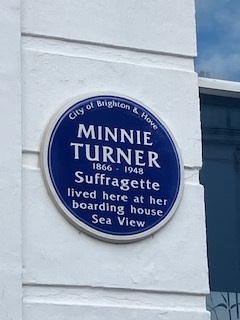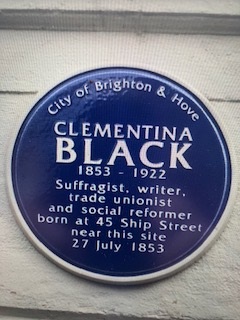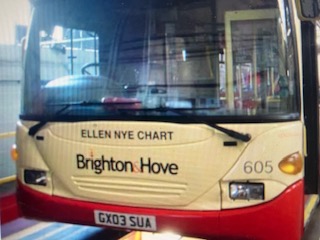Brighton and Hove Women’s History Group (BHWHG) seek to identify, celebrate and gain recognition for women who have contributed to the history of Brighton and Hove. As part of this mission, we aim to support the installation of blue plaques in relevant locations, and to draw attention to those already in place.
Women are often less well recognised as in times past they usually did not have equal access to educational opportunities, professional qualifications, or moneyed patronage. Until the early 20th century they did not have the right to vote, their legal status was heavily circumscribed, they shouldered disproportionate domestic and family responsibilities and were often barred from practising a profession or trade. This makes their commitment and achievements all the more impressive, but less likely to have been formally publicised or recorded. The BHWHG aims to counter this in their research, awareness raising and campaigning for formal recognition.
The Mary Hare plaque, installed in March 2024 and championed by BHWHG member Margaret Stewart, is just the most recent of these projects: The Story of the Blue Plaque Champion. There is also the long running campaign for a statue of Mary Clarke, leading suffragette and the first women to die in the cause of suffrage. This is led by another BHWHG member, Jean Calder, and recently saw Brighton Council award Mary Clarke the Freedom of the City.
Earlier, the Group championed four blue plaques around the City to commemorate the women’s suffrage movement, on the 100th anniversary in 2018 of some women becoming enfranchised. The first plaque was for the Women’s Social and Political Union (WSPU) Office at the Quadrant (Clock Tower), with a campaign led by Liz Dwiar and Maria Hogg. Three plaques followed for individual suffragettes: Minnie Turner in Victoria Road ; Elizabeth Robins and Olivia Wilberforce in Montpelier Crescent and Clementina Black in Ship Street. Subsequently the Group also supported Peter Kyle MP in commemorating trade unionist, MP and first female cabinet minister Margaret Bondfield, whose plaque is in Church Road, Hove.




The next great women we are campaigning for include Margaret Hardy (1874-1954), the first female mayor of Brighton, and Ellen Nye Chart (1839-1892), manager of the Theatre Royal, Brighton.
In selecting the individuals we support in this way, we broadly follow the Historic England blue plaque criteria, but with a more creative and inclusive remit:
– Has a strong personal link to Brighton or Hove (born, lived, worked)
– Their work/life made a significant contribution to human welfare or happiness in a city-wide, national or international context
– There is an identifiable existing building or structure – an associated address – on which to affix a plaque
– Visible from a public highway
– Owner gives permission
– Council gives permission if in conservation area
– May have been recognised in their lifetime, or since, but not necessarily – part of the B&HWHG mission is to widen the scope of recognition
– At least twenty years have passed since their death
BHWHG may support individuals or organisations who seek to celebrate women or locations important to women in Brighton and Hove in the past
– The Group has diverse relevant experience and can provide practical advice
– We are seeking to commemorate a range of contrasting professions and profiles
– For plaques, the individual champion needs to raise funds of around £1,000 for creation and installation of the plaque, and consider the additional cost of staging a ceremony, if wanted eg producing programmes, venue, catering.
– It is worth looking for potential partnerships with organisations relevant to the individual for sponsorship and/or additional publicity if wantedeg schools, professional bodies
There are other ways to enhance awareness of individual women and relevant locations, and we can also discuss and advise on these eg, research, published works, talks, and walks. A self-guided walk round central Brighton sites celebrating notable women is available on our website, and includes the five blue plaques sponsored by the BHWHG. Naming buses after local figures is also a Brighton tradition, and the Group has successfully proposed the names of many women to be displayed on the front of the fleet.
We have a booklet ‘Women of Brighton & Hove: An Anthology’, for which we are planning a second, expanded edition, and this website where we publish new research.

